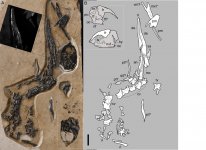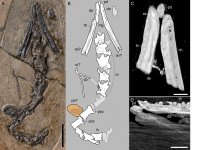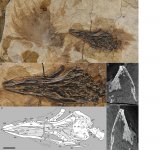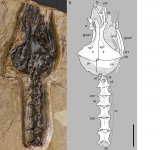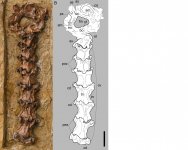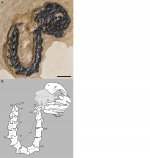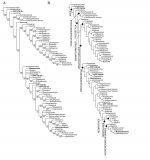Fred Ruhe
Well-known member

Jingmai K. O'Connor, Thomas A. Stidham. Jerald D. Harris, Matthew C. Lamanna, Alida M. Bailleul, Han Hu, Min Wang et Hailu You, 2022
Avian skulls represent a diverse ornithuromorph fauna from the Lower Cretaceous Xiagou Formation, Gansu Province, China
Journal of Systematics and Evolution. in press.
doi:10.1111/jse.12823
Abstract: https://onlinelibrary.wiley.com/doi/10.1111/jse.12823
We describe six specimens consisting of cranial remains and associated partial presacral axial series belonging to ornithuromorph birds from the Changma locality of the Lower Cretaceous Xiagou Formation of northwestern Gansu Province, China. Comparison among specimens is limited by the paucity of overlapping elements, their differing exposed views, and, in some specimens, poor preservation. Despite this, three separate taxa are represented, evidenced by differences in their dentary dentitions: one specimen is edentulous, another has sharp, closely spaced, relatively high-crowned and peg-like teeth, and a third preserves blunt, relatively low-crowned teeth placed in a communal groove, a morphology previously reported among adult birds only in Hesperornithiformes. We propose that the high-crowned specimen may be referred to Gansus yumenensis based on shared similarities with the closely related Iteravis huchzermeyeri, including a very similar dentition and an edentulous premaxilla with elongate, unfused frontal processes and no palatal processes. The two other specimens are considered new taxa, for which we erect the names Meemannavis ductrix gen. et sp. nov. and Brevidentavis zhangi gen. et sp. nov. These new specimens confirm that the Changma locality is dominated by ornithuromorph birds and contribute to a better understanding of this important avifauna. The observed variation in dental morphology hints at trophic diversity like that observed in ornithuromorphs from the penecontemporaneous Jehol Group of northeastern China.
Enjoy,
Fred
P.S. I hope someone is willing to send me the pdf of this paper, using WeTranfer, or to f,ruhe@upcmail,nl
Thanks in advance,
Avian skulls represent a diverse ornithuromorph fauna from the Lower Cretaceous Xiagou Formation, Gansu Province, China
Journal of Systematics and Evolution. in press.
doi:10.1111/jse.12823
Abstract: https://onlinelibrary.wiley.com/doi/10.1111/jse.12823
We describe six specimens consisting of cranial remains and associated partial presacral axial series belonging to ornithuromorph birds from the Changma locality of the Lower Cretaceous Xiagou Formation of northwestern Gansu Province, China. Comparison among specimens is limited by the paucity of overlapping elements, their differing exposed views, and, in some specimens, poor preservation. Despite this, three separate taxa are represented, evidenced by differences in their dentary dentitions: one specimen is edentulous, another has sharp, closely spaced, relatively high-crowned and peg-like teeth, and a third preserves blunt, relatively low-crowned teeth placed in a communal groove, a morphology previously reported among adult birds only in Hesperornithiformes. We propose that the high-crowned specimen may be referred to Gansus yumenensis based on shared similarities with the closely related Iteravis huchzermeyeri, including a very similar dentition and an edentulous premaxilla with elongate, unfused frontal processes and no palatal processes. The two other specimens are considered new taxa, for which we erect the names Meemannavis ductrix gen. et sp. nov. and Brevidentavis zhangi gen. et sp. nov. These new specimens confirm that the Changma locality is dominated by ornithuromorph birds and contribute to a better understanding of this important avifauna. The observed variation in dental morphology hints at trophic diversity like that observed in ornithuromorphs from the penecontemporaneous Jehol Group of northeastern China.
Enjoy,
Fred
P.S. I hope someone is willing to send me the pdf of this paper, using WeTranfer, or to f,ruhe@upcmail,nl
Thanks in advance,
Last edited:




